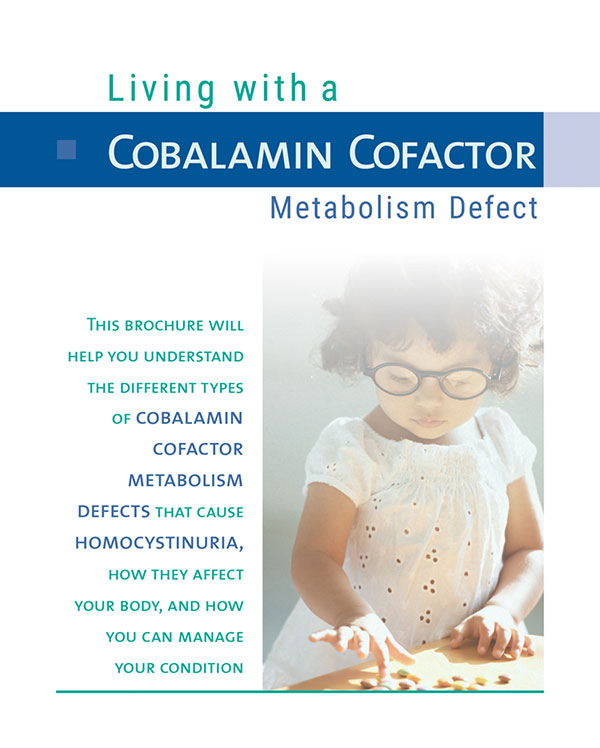Homocystinuria caused by COBALAMIN COFACTOR METABOLISM (cbl) DEFECT
Homocystinuria caused by cobalamin cofactor metabolism (cbl) defect occurs when the body cannot properly process cobalamin (vitamin B12). This activity is essential for converting an important amino acid—homocysteine—back to methionine, another important amino acid. When the body cannot process vitamin B12 as it should, blood levels of homocysteine increase, and blood levels of methionine decrease. This causes harmful symptoms to develop.
What are the different types of cobalamin cofactor metabolism defects?
The body goes through a series of steps to process vitamin B12. Errors can occur in each of these steps. This leads to many types of cbl defects that cause homocystinuria: cblC, cblD, cblD variant 1, cblE, cblF, cblG, cblJ, and cblX.
By far the most common and best understood type of cbl defect is cblC defect. CblC defect causes two disorders: homocystinuria and methylmalonic acidemia (MMA). MMA occurs when methylmalonic acid builds up in the blood. The body makes tiny amounts of methylmalonic acid when digesting protein. But a high level of methylmalonic acid in the blood can also cause harmful symptoms to develop. CblD, cblF, cblJ, and cblX defects also cause both homocystinuria and MMA. These are known as combined disorders.
Homocystinuria without methylmalonic acidemia occurs in people with cblD variant 1, cblE, or cblG defect. These are known as single disorders.
What are the signs and symptoms of homocystinuria caused by cblC defect?
Symptoms of homocystinuria caused by cblC defect can develop for the first time at any age and can vary greatly from person to person.
Early-onset form of cblC defect
Most people with cblC defect develop signs and symptoms before they are a year old. This is the “early-onset” form of cblC defect. Symptoms that may develop include:
- Vision symptoms, such as rapid, uncontrolled, or wandering/scanning eye movements
- Small head and brain size (microcephaly)
- Symptoms related to the brain and spinal cord, such as seizures, drowsiness or lack of energy, or floppy muscles and joints
- Eating or growth problems, such as not wanting to nurse or take a bottle, or failure to grow and gain weight as expected
- Kidney blockages caused by damaged red blood cells
- Other symptoms involving the blood, heart, or lungs, such as anemia, heart disease, or blood clots
- Developmental delay or disability, such as being slow to sit up, walk, or talk
Late-onset form of cblC defect
People with a milder form of cblC defect may not develop symptoms until later in life—from childhood to adulthood. This is the “late-onset” form of cblC defect. Symptoms that may develop include:
Although less is known about other cbl defects that cause homocystinuria, they tend to cause some of the same symptoms as cblC defect.
Early detection and treatment are critical to help reduce
serious health problems.
How is homocystinuria caused by cbl defect diagnosed?
Most states screen newborns for cbl defects with combined homocystinuria and methylmalonic acidemia, such as cblC and cblD, by looking for markers in the blood caused by high levels of methylmalonic acid (MMA). To learn if this test is offered in your state, visit babysfirsttest.org.
If someone has a positive newborn screen and/or symptoms that could be signs of homocystinuria caused by a cbl defect, your doctor will order lab tests. The following results may point to a positive diagnosis for most types of cbl defect, including cblC defect:
- High levels of homocysteine in blood and urine
- Low levels of methionine in blood and urine
- High levels of methylmalonic acid in blood and urine (indicates methylmalonic acidemia, which always occurs with cblC defect and also occurs with some other cbl defects)
Genetic testing can confirm the diagnosis.
Medical geneticists are doctors who specialize in diagnosing
and treating people with cobalamin cofactor metabolism defect.
How is homocystinuria caused by cbl defect treated?
The overall goal of treatment is to prevent or lessen symptoms by keeping homocysteine, methionine, and methylmalonic acid (MMA) levels in your body as close to normal as possible. Treatment may include:
- Getting injections of hydroxocobalamin (the only effective form of vitamin B12)
- Taking CYSTADANE® (betaine anhydrous for oral solution)
- Taking other therapies as directed by your doctor
Always check with your doctor about what therapies are right for you.
INDICATIONS AND USAGE
CYSTADANE (betaine anhydrous for oral solution) is indicated in children and adults for the treatment of homocystinuria to decrease high homocysteine blood levels. Homocystinuria is a rare genetic disorder in which there is an abnormal accumulation of the amino acid homocysteine in the blood and urine. The following are considered to be homocystinuria disorders:
- Cystathionine beta-synthase (CBS) deficiency
- 5,10-methylenetetrahydrofolate reductase (MTHFR) deficiency
- Cobalamin cofactor metabolism (cbl) defect
IMPORTANT SAFETY INFORMATION
- Hypermethioninemia in Patients with CBS Deficiency: CYSTADANE may worsen high methionine blood levels and accumulation of excess fluid in the brain has been reported. If you have been told you have CBS deficiency, your doctor will be monitoring your methionine blood levels to see if changes in your diet and dosage are necessary.
- Most common side effects were nausea and gastrointestinal distress, based on a survey of doctors.
- To report SUSPECTED SIDE EFFECTS, contact Recordati Rare Diseases Inc. at 1-888-575-8344, or FDA at 1-800-FDA-1088 or www.fda.gov/medwatch.
IMPORTANT SAFETY INFORMATION
- Hypermethioninemia in Patients with CBS Deficiency: CYSTADANE may worsen high methionine blood levels and accumulation of excess fluid in the brain has been reported. If you have been told you have CBS deficiency, your doctor will be monitoring your methionine blood levels to see if changes in your diet and dosage are necessary.
- Most common side effects were nausea and gastrointestinal distress, based on a survey of doctors.
